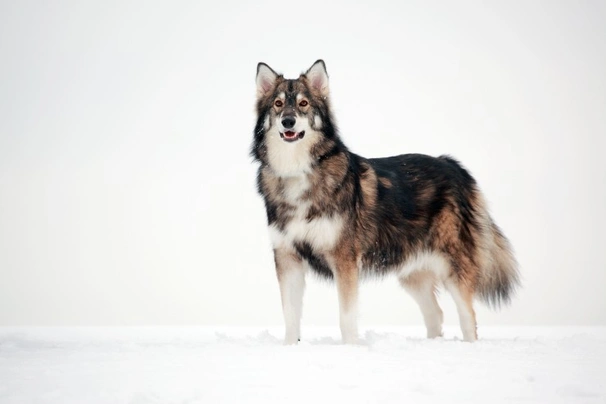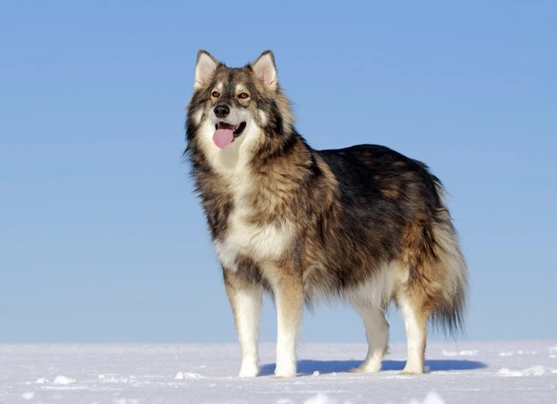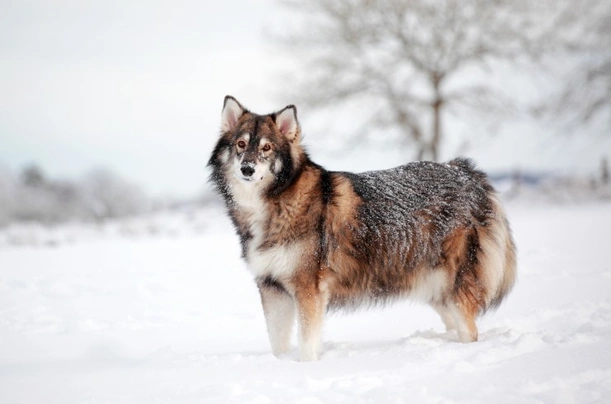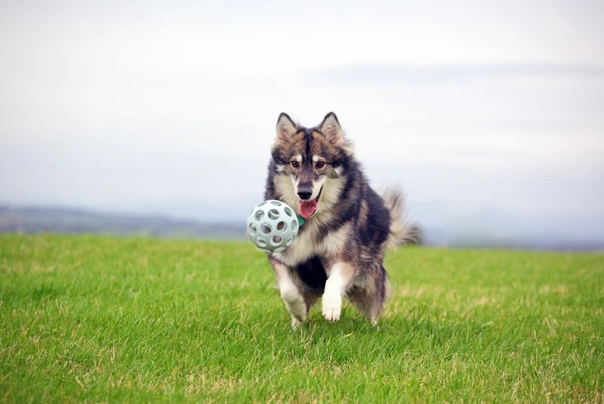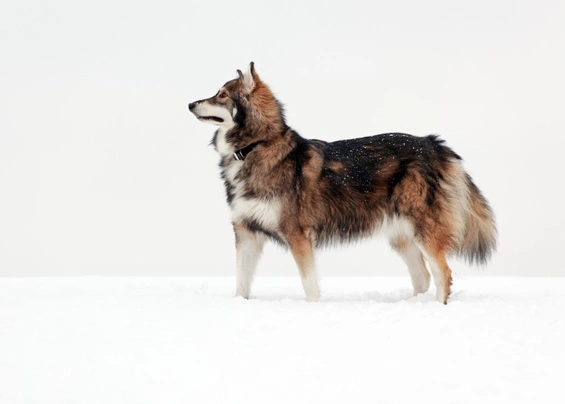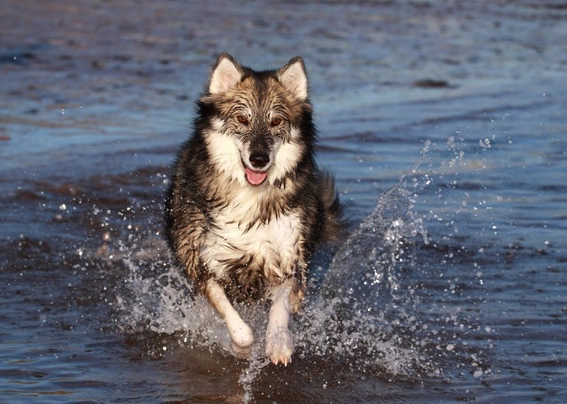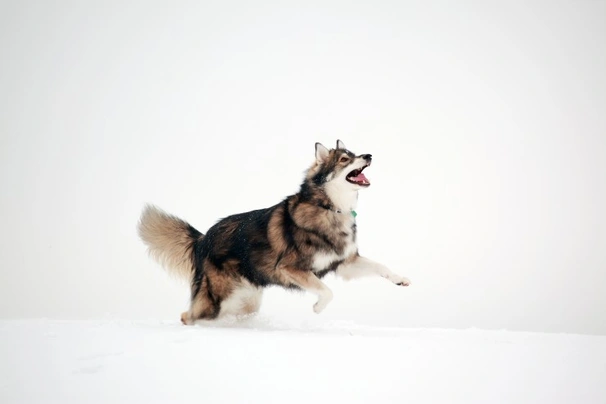Utonagan
Pros
Cons
Introduction of the Utonagan
The Utonagan was named after an ancient Chinook Indian tale which means "spirit of the wolf". The very first pair of dogs were introduced into the UK during the late 1980's and although still rare the breed is gaining recognition here in the UK albeit slowly. Bred to look like wolves but with the character and temperament of a domestic dog the Utonagan is often seen being used as PAT therapy dogs in schools hospitals as well as hospices and are known to be highly adaptable and intelligent.
Although Utonagans may look like wolves there is no “wolf” in their DNA and rarely would a dog show any sort of aggressive behaviour. They are not the best choice for first time owners because a Utonagan needs to be socialised trained and handled by people who are familiar with their specific needs and who lead active outdoor lives. With this said Utonagans make wonderful family pets and in the right hands are easy to train.
History of the Utonagan
The Utonagan was bred to look like a wolf although there is no "wolf" in their DNA whatsoever. The breeds used to create them were the Alaskan Malamute the Siberian Husky and the German Shepherd so in fact they are the result of crossing three domestic breeds. The dogs we see today are in fact the result of crossing five dogs that were introduced to the UK in 1987 from America. These dogs were rescues and as such their origins remain unknown.
It was then that breeders in the UK introduced Alaskan Malamute German Shepherd and Siberian Husky into the mix with an end goal being to create a specific look to the breed. These original Utonagans were bred by a lady called Edwina Harrison and she offered the offspring of her crossings for sale calling them "Wolf-Dogs" but the name was unpopular so she renamed them Northern Inuits a few years later only to change the breed's name yet again to Utonagans further down the line.
As such the Utonagan and the Northern Inuit share the same ancestry with the sole difference being that the breeder bred specific lines of Utonagans which led to the two breeds being recognised as different to one another. To complicate things a little more breed clubs were set up that reflected a different way of developing the breed and these included The Utonagan Association The Utonagan Club The British Utonagan Association and the Utonagan Society although the breed is not recognised by the Kennel Club (January 2018) or other major international associations.
Through careful and selective breeding to reduce the risks of health issues breeders collected precise records of all dogs used in breeding programmes which was especially the case for The British Utonagan Association. Dogs were routinely and meticulously health tested with the end goal being to not only improve the Utonagan's health but as a way of gaining Kennel Club recognition too. However by 2011 the British Utonagan Association decided to cease any involvement with the breed club thanks to a difference of opinion on how the development of the breed should continue.
This decision resulted in two "types" of Utonagans with one of them being referred to as "British Utonagans". These dogs are loosely based on what is now referred to as the "original Utonagan" with the difference being that puppies produced are the result of crossing a Utonagan with either a German Shepherd a Siberian Husky or a Northern Inuit which are the 3 founding dog breeds.
Over the last ten years these handsome dogs have gained a little more recognition mainly due to the breed becoming more established. They were bred to be companion dogs that boasted very wolf-like looks but with the characteristics of an adaptable highly intelligent and biddable domestic dog. The result is a dog that's highly intelligent and very adaptable with the elegant appearance of a wolf and today many Utonagans are regularly trained and used as PAT therapy dogs in all sorts of situations which includes in hospitals hospices and schools which is proof of just how adaptable and biddable they are.
As previously mentioned the breed is not recognised by The Kennel Club (January 2018) and anyone wishing to share their home with a Utonagan would need to register their interest with breeders and agree to being put on a waiting list as so few healthy well-bred puppies are bred every year bearing in mind that a puppy can often command a lot of money as a result.
Interesting facts about the breed
- Is the Utonagan a vulnerable breed? No although anyone wanting to share a home with a Utonagan would need to register their interest with breeders for the pleasure of doing so
- The Utonagan and the Northern Inuit share the same ancestry but are 2 separate breeds
- They are highly intelligent and often used as PAT dogs thanks to their kind and dependable natures
- Although wolf-like in appearance the Utonagan shows no sign of aggression whatsoever
Appearance of the Utonagan
Height at the withers: Males 63 - 84 cm Females 61 - 71 cm
Average weight: Males 32 - 50 kg Females 25 - 41 kg
The Utonagan is a large muscular strong yet athletic looking dog thanks to their lighter build. They are extremely well-balanced and it is this that reflects their agility speed and power. Their overall first impression is that of a wolf although there is no wolf in their DNA.
Their heads are nicely in proportion with the rest of their bodies and never too broad. They have a slight stop that is never exaggerated. Muzzles are strong being a little longer than a dog's skull and their lips are tight. Noses are either dark brown or black. Eyes are almond shaped with the colour being anything from a darkish brown to a lightish amber but the preferred eye colour is yellow.
Their ears are spaced well apart with slightly rounded tips. Mouths are strong with dogs having long tapered muzzles with powerful well-developed jaws and perfect scissor bites. Necks are strong long and nicely muscled with dogs having a mane which gives the appearance of their necks being on the heavier side. Chests are narrow with moderately sloping shoulders. Front legs are long and straight being narrowly spaced apart with elbows being set close to a dog's body.
They have very streamlined chests and well-muscled loins with dogs having long bodies and nice level toplines. Hindquarters are well-muscled and powerful with a dog's back legs being nicely spaced and parallel to one another. Hocks are strong and stifles slightly bent. Front feet are large and oval shaped being set straight whereas their back feet are slightly smaller. Both front and back feet are webbed.
Tails are bushy and thick being evenly covered without being too feathered. Dogs carry their tails high and straight when they are on the move and lower when at rest. Utonagans with coloured coats should have a black tip to the tail.
When it comes to their coat the Utonagan boasts having a close tight straight coat that's quite different during the warmer summer months than it is in the wintertime. During the colder winter months dogs have profuse undercoats that cover their entire bodies which includes on the insides of their ears. However during the warmer summer months their coats are very noticeably less dense. Their necks are well covered in hair forming a slight ruff which frames a dog's head. The accepted colours for a Utonagan include the following:
- Grey
- Black
- Tan
- Buff
All Utonagans have darker clearly defined masks
Gait/movement
When a Utonagan moves they do so with effortless grace taking long loping strides and showing a tremendous amount of power in their hindquarters.
Faults
Longer coated Utonagans should not have too much feathering around their ears their abdomens legs or their tails. Other faults include the following:
- Black and all white coats
- White masks
- Pied and ink-marked colours
- Blue eyes
- Soft ears
- Undershot or overshot jaws
- Dew claws on back feet
- Curly or spitz-type tails
It is also worth noting that monorchid males should never be used for breeding purposes and that both testicles should be normally formed and fully descended into their scrotums.
Temperament of the Utonagan
The Utonagan is an intelligent friendly dog and one that boasts a well-balanced even temperament. As such they are known to be wonderful family pets and companions loving nothing more than being in a home environment and involved in everything that goes on around them. They are particularly good around children and when well socialised from a young enough age they generally get on well with other pets and animals too. They are never happier than when they live with other dogs because they have a very strong "pack" mentality which is deeply embedded in their psyche.
However they need to know their place in the pack and who is the alpha dog in a household which means they need to be handled and trained with firm fair and gentle hand. These dogs thrive on knowing who they can look to for direction and guidance or they might take on the role of the more dominant dog. With this said the Utonagan is not known to have any aggressiveness about them.
They form strong bonds with their owners and in particular with the person who usually takes care and feeds them. The downside to this is they don't like to be left on their own for any length of time. As such they are best suited to families where at least one person stays at home when everyone else is out of the house so a dog is never left to their own devices for too long.
It's important for these dogs to be well socialised from a young age so they grow up to be confident outgoing mature dogs. Their socialisation must include introducing them to lots of new situations noises people other animals and dogs once they have been fully vaccinated. It's also crucial for their training to start early too and it should be consistent throughout a dog's life.
They can be a little boisterous at times especially when young but with the right amount of socialisation and training the Utonagan is a well-behaved and obedient dog and one that excels at all sorts of canine sports which includes activities like agility and flyball. They are also often seen being used as PAT therapy dogs which shows just how adaptable and biddable a Utonagan can be when well-handled and trained.
They are not the best choice for first time owners because these smart quick thinking dogs need to be handled and trained by people who are familiar with the needs of this type of high energy dog. They are best suited to people who lead active outdoor lives and who enjoy having an intelligent canine companion at their side.
Are they a good choice for first time owners?
The Utonagan is not the best choice for first time dog owners because they are better suited to people who are familiar with their specific needs. These highly intelligent dogs need a tremendous amount of exercise and mental stimulation to be truly happy and they are never happy when left to their own devices for too long.
What about prey drive?
Utonagans are very social by nature but they do have a high prey drive and as such care should be taken as to where and when they can run off the lead more especially when livestock or wildlife is close by. The good news is that the Utonagan is highly intelligent and in the right hands with the correct training they can be taught not to leave an owner's side even when they are off the lead.
What about playfulness?
Utonagans have a very playful side to their natures and love to entertain and be entertained. They are known to be a little mischievous when the mood takes them and being so clever they quickly learn what pleases an owner. They adore taking part in all sorts of interactive games and canine sports which includes obedience and agility to name but two. They are also especially good at tracking and love to follow their noses to find things.
What about adaptability?
Utonagans are better suited to people who have very secure back gardens a dog can safely roam in whenever possible bearing in mind that fencing must be high and ultra-secure to keep these athletic dogs in.
What about separation anxiety?
Utonagans form extremely strong ties with their families and dogs are never very happy when they find themselves left on their own for longer periods of time. They are better suited to people who either work from home or in households where one person stays at home when everyone else is out so they are never alone for any length of time which could see a dog suffering from separation anxiety. This can lead to them being destructive around the home which is a dog's way of relieving any stress they are feeling and a way to keep themselves entertained.
What about excessive barking?
Some Utonagans like the sound of their own voices a little too much which is something that needs to be gently nipped in the bud when a dog is still young being careful not to frighten them. Others will only bark when there are strangers about or when something they don't like is going on in their surroundings. Having said this they are known to have quite a unique "voice" and take great pleasure in "howling" for the sake of it when the mood takes them.
Do Utonagans like water?
Most Utonagans love swimming and will take to the water whenever they can more especially when the weather is hot. However if anyone who owns a dog that does not like water should never force them to go in because it would just end up scaring them. With this said care should always be taken when walking a Utonagan off the lead anywhere near more dangerous watercourses just in case a dog decides to leap in and then needs rescuing because they cannot get out of the water on their own.
Are Utonagans good watchdogs?
Utonagans are not natural watchdogs although this is not to say a dog would not be quick off the mark to let an owner know when there are strangers about although they would rarely do this aggressively preferring to keep their distance and bark as a way of alerting their owners to something they don't like that may be going on.
Intelligence / Trainability of the Utonagan
The Utonagan is a highly intelligent dog that's quick-witted character. They learn things quickly with the downside to this being they are just as fast to pick up bad behaviours and habits too. As such they need to be well socialised from a young age and their training must begin early too. It must be consistent and always fair so that dogs understand what their owner expects of them.
Utonagans are never happier than when they are given something to do which is why they are so amenable to learning new things but they need to be handled with a firm yet gentle hand. In the right hands they excel at many canine sports which includes activities like flyball agility and obedience because they thrive on the attention they are given during their training and the one-to-one contact they have with their owners when they are competing.
The key to successfully training a Utonagan is to make their training as interesting as possible and to avoid too much repetition. It's also a good idea to keep training sessions that much shorter which helps keep a dog more focused on what they are being asked to do bearing in mind that the more intelligent a dog is the faster they get bored. They are sensitive dogs by nature which means they do not answer well to any sort of harsh correction or heavier handed training methods but they do respond well to positive reinforcement which always brings the best out of these clever dogs.
Utonagan puppies are incredibly cute and it is all too easy to spoil them when they first arrive in their new homes. As such it is important for owners to start out as they mean to go on bearing in mind that Utonagans grow into impressive large dogs that can be more dominant by nature. Rules and boundaries must be set out as soon as a puppy is settled in so they understand what an owner expects of them. It also helps establish a “pecking” order as early as possible establishing who is the alpha dog in a household. Puppies must be taught what is acceptable behaviour and what is not. It is also a good idea to teach a puppy that playtime takes place outside to avoid any breakages around the home. The first commands a Utonagan puppy should be taught are as follows:
- Come
- Sit
- Stay
- Heel
- Quiet
- Leave it
- Down
- Bed
Children and other
Utonagans are known to be very good around children thanks to their gentle placid natures. However because of their large size and the fact they can be quite boisterous at times any interaction between toddlers and a dog should always be well supervised by an adult to make sure playtime does not get too boisterous which could end up with someone being knocked over and hurt.
When dogs have been well socialised from a young enough age they generally get on well with other dogs they meet. If they have grown up with a family cat in a household they usually get on well together and they generally get on with other animals they have grown up with. However a Utonagan would think nothing of chasing off any other cats they encounter because they would see them as fair game.
Health of the Utonagan
The average life expectancy of a Utonagan is between 10 and 15 years when properly cared for and fed an appropriate good quality diet to suit their ages.
The Utonagan is such a new breed that more information is needed to know if these handsome dogs are affected by any hereditary and congenital health issues the breeds used to create them often suffer from. With this said breeders should have their stud dogs hip scored and eye tested before using them in a breeding programme. The conditions that more commonly affect the Utonagan parent breeds include the following:
- Hip dysplasia - dogs should be hip scored
- Elbow dysplasia - dogs should be tested
- Addison's disease
- Epilepsy
- Von Willebrand's disease
- Renal disease
- Heart defects
- Endocrine issues
It is worth noting that only Utonagans that do not have any hereditary eye issues and good hip scores should be used for breeding purposes with a dog’s hip score average being 18.
What about vaccinations?
Utonagan puppies would have been given their initial vaccinations before being sold but it is up to their new owners to make sure they have their follow-up shots in a timely manner with the vaccination schedule for puppies being as follows:
- 10 -12 weeks old bearing in mind that a puppy would not have full protection straight away but would be fully protected 2 weeks after they have had their second vaccination
There has been a lot of discussion about the need for dogs to have boosters. As such it's best to talk to a vet before making a final decision on whether a dog should continue to have annual vaccinations which are known as boosters.
What about spaying and neutering?
A lot of vets these days recommend waiting until dogs are slightly older before spaying and neutering them which means they are more mature before undergoing the procedures. As such they advise neutering males and spaying females when they are between the ages of 6 to 9 months old and sometimes even when a dog is 12 months old.
Other vets recommend spaying and neutering dogs when they are 6 months old but never any earlier unless for medical reasons. Wtih this said many breeds are different and it is always advisable to discuss things with a vet and then follow their advice on when a dog should be spayed or neutered.
What about obesity problems?
Like other breeds some Utonagans gain weight after they have been spayed or neutered although given their athletic light build this is not always the case. However it's important to keep an eye on a dog's waistline just in case they do. If a dog starts to put on weight it's important to adjust their daily calorie intake and to up the amount of exercise they are given. Older dogs too are more prone to gaining weight and again it's essential they be fed and exercised accordingly because obesity can shorten a dog's life by several years. The reason being that it puts a lot of extra strain on a dog's internal organs including the heart which could prove fatal.
What about allergies?
Utonagans are not prone to suffering from allergies but if a problem does flare up it’s important for them to see a vet sooner rather than later because any sort of allergy can be notoriously hard to clear up and finding the triggers challenging. With this said a vet would be able to make a dog with an allergy more comfortable while they try to find out the triggers which could include the following:
- Certain dog foods that contain high levels of cereals and other grain-type fillers
- Airborne pollens
- Dust mites
- Environment
- Flea and tick bites
- Chemicals found in everyday household cleaning products
Participating in health schemes
All responsible Utonagan breeders would ensure that their stud dogs are tested for known hereditary and congenital health issues known to affect the breed by using the following schemes:
- Hip scoring - through the Animal Health Trust or BVA
- Elbow testing - through the Animal Health Trust or BVA
What about breed specific breeding restrictions?
The Utonagan is not a Kennel Club registered breed as such there are not breed specific breeding restrictions for the breed. However all responsible breeders would ensure the puppies they produce are bred from healthy parents and that inbreeding is avoided at all costs.
What about Assured Breeder Requirements?
Because the Utonagan is not a Kennel Club registered breed there are no Assured Breeder requirements in place for the breed but all breeders should make sure their breeding dogs are free of any hereditary eye issues and that they have acceptable hip scores to prevent them passing any health issues onto their offspring.
Caring for the Utonagan
As with any other breed Utonagans need to be groomed on a regular basis to make sure their coats and skin are kept in top condition. They also need to be given regular daily exercise to ensure they remain fit and healthy. On top of this dogs need to be fed good quality food that meets all their nutritional needs throughout their lives.
Caring for a Utonagan puppy
Utonagan puppies are boisterous and full of life which means it's essential for homes and gardens to be puppy-proofed well in advance of their arrival. They can be quite destructive around the home too and need to be given a tremendous amount of attention. A responsible breeder would have well socialised their puppies which always leads to more outgoing confident and friendly dogs right from the word go. With this said any puppy is going to feel vulnerable when they leave their mother and littermates which must be taken into account. The longer a puppy can remain with their mother the better although it should never be for too long either.
It's best to pick a puppy up when people are going to be around for the first week or so which is the time needed for a puppy to settle in. Puppy-proofing the home and garden means putting away any tools and other implements that a boisterous puppy might injure themselves on. Electric wires and cables must be put out of their reach because puppies love chewing on things. Toxic plants should be removed from flowerbeds and the home too.
Puppies need to sleep a lot to grow and develop as they should which means setting up a quiet area that's not too out of the way means they can retreat to it when they want to nap and it's important not to disturb them when they are sleeping. It's also a good idea to keep "playtime" nice and calm inside the house and to have a more active "playtime" outside in the garden which means puppies quickly learn to be less boisterous when they are inside.
The documentation a breeder provides for a puppy must have all the details of their worming date and the product used as well as the information relating to their microchip. It is essential for puppies to be wormed again keeping to a schedule which is as follows:
- Puppies should be wormed at 6 months old
- They need to be wormed again when they are 8 months old
- Puppies should be wormed when they are 10 months old
- They need to be wormed when they are 12 months old
Things you'll need for your puppy
There are certain items that new owners need to already have in the home prior to bringing a new puppy home. It's often a good idea to restrict how much space a puppy plays in more especially when you can't keep an eye on what they get up to bearing in mind that puppies are often quite boisterous which means investing in puppy gates or a large enough playpen that allows a puppy the room to express themselves while keeping them safe too. The items needed are therefore as follows:
- Good quality puppy or baby gates to fit on doors
- A good well-made playpen that's large enough for a puppy to play in so they can really express themselves as puppies like to do
- Lots of well-made toys which must include good quality chews suitable for puppies to gnaw on bearing in mind that a puppy will start teething anything from when they are 3 to 8 months old
- Good quality feed and water bowls which ideally should be ceramic rather than plastic or metal
- A grooming glove
- A slicker brush or soft bristle brush
- Dog specific toothpaste and a toothbrush
- Scissors with rounded ends
- Nail clippers
- Puppy shampoo and conditioner which must be specifically formulated for use on dogs
- A well-made dog collar or harness
- A couple of strong dog leads
- A well-made dog bed that's not too small or too big
- A well-made dog crate for use in the car and in the home that's large enough for a puppy to move around in
- Baby blankets to put in your puppy's crate and in their beds for when they want to nap or go to sleep at night
Keeping the noise down
All puppies are sensitive to noise including Utonagan puppies bearing in mind that they are ultra-sensitive by nature anyway. It's important to keep the noise levels down when a new puppy arrives in the home. TVs and music should not be played too loud which could end up stressing a small puppy out.
Keeping vet appointments
As previously mentioned Utonagan puppies would have been given their first vaccinations by the breeders but they must have their follow up shots which is up to their new owners to organise. The vaccination schedule for puppies is as follows:
- 10 -12 weeks old bearing in mind that a puppy would not have full protection straight away but would only be fully protected 2 weeks after they have had their second vaccination
When it comes to boosters it's best to discuss these with a vet because there is a lot of debate about whether a dog really needs them after a certain time. However if a dog ever needed to go into kennels their vaccinations would need to be fully up to date.
What about older Utonagans when they reach their senior years?
Older Utonagans need lots of special care because as they reach their golden years they are more at risk of developing certain health concerns. Physically a dog's muzzle may start to go grey but there will be other noticeable changes too which includes the following:
- Coats become coarser
- A loss of muscle tone
- Utonagans can either become overweight or underweight
- They have reduced strength and stamina
- Older dogs have difficulty regulating their body temperature
- They often develop arthritis
- Immune systems do not work as efficiently as they once did which means dogs are more susceptible to infections
- Older dogs change mentally too which means their response time tends to be slower as such they develop the following:
- They respond less to external stimuli due to impaired vision or hearing
- They tend to be a little pickier about their food
- They have a lower pain threshold
- Become intolerant of any change
- Often an older dog can feel disorientated
Living with a Utonagan in their golden years means taking on a few more responsibilities but these are easily managed and should include taking a look at their diet the amount of exercise they are given how often their dog beds need changing and keeping an eye on the condition of their teeth.
Older Utonagans need to be fed a good quality diet that meets their needs at this stage of their lives all the while keeping a close eye on a dog's weight. A rough feeding guide for older dogs is as follows bearing in mind they should be fed highly digestible food that does not contain any additives:
- Protein content should be anything from 14 – 21%
- Fat content should be less than 10%
- Fibre content should be less than 4%
- Calcium content should be 0.5 – 0.8%
- Phosphorous content should be 0.4 – 0.7%
- Sodium content should be 0.2 – 0.4%
Older dogs don't need to be given the same amount of daily exercise as a younger dog but they still need the right amount of physical activity to maintain muscle tone and to prevent a dog from putting on too much weight. All dogs need access to fresh clean water and this is especially true of older dogs when they reach their golden years because they are more at risk of developing kidney disorders.
Grooming of the Utonagan
The Utonagan boasts having a close tight straight coat that's a lot more profuse during the winter months than it is in the summertime. They are quite high maintenance on the grooming front in the winter but less so during the summer. As such they need to be groomed more frequently over the colder months and only need a twice weekly brush when the weather is warmer to remove any loose and dead hair from their coats.
It's also important to check a dog's ears on a regular basis and to clean them when necessary. If too much wax builds up in a dog's ears it can lead to a painful infection which can be hard to clear up. In short prevention is often easier than cure when it comes to ear infections.
Exercise of the Utonagan
The Utonagan is a high energy intelligent and often boisterous dog and as such they need to be given the right amount of daily exercise and mental stimulation for them to be truly happy well-rounded characters. They need a minimum of 60-minutes exercise a day with as much off the lead time as possible but only in a safe and secure environment. If they are not given the right amount of mental stimulation and exercise every day a Utonagan would quickly get bored and could even begin to show some destructive behaviours around the home which is their way of relieving any stress they are feeling and not necessarily because they are being naughty.
A shorter walk in the morning would be fine but a longer more interesting one in the afternoon is a must with as much off the lead time as possible. These dogs also like to be able to roam around a back garden as often as possible so they can really let off steam. However the fencing must be extremely secure to keep these athletic high energy dogs in because if they find a weakness in the fence they will soon escape and could get into all sorts of trouble.
However because they have such dense coats the Utonagan can easily overheat if they are given too much exercise when the weather is warmer and ideally they should only be walked when the temperature is cooler which is typically earlier in the morning and then later in the evening during the summertime. With this said Utonagan puppies should not be over exercised because their joints and bones are still growing. This includes not letting a dog jump up and down from furniture or going up or down the stairs. Too much pressure placed on their joints and spines at an early age could result in a dog developing serious problems later in their lives.
Feeding of the Utonagan
If you get a Utonagan puppy from a breeder they would give you a feeding schedule and it's important to stick to the same routine feeding the same puppy food to avoid any tummy upsets. You can change a puppy's diet but this needs to be done very gradually always making sure they don't develop any digestive upsets and if they do it's best to put them back on their original diet and to discuss things with the vet before attempting to change it again.
Older dogs are not known to be fussy eaters but this does not mean they can be given a lower quality diet. It's best to feed a mature dog twice a day once in the morning and then again in the evening making sure it's good quality food that meets all their nutritional requirements. It's also important that dogs be given the right amount of exercise so they burn off any excess calories or they might gain too much weight which can lead to all sorts of health issues. Obesity can shorten a dog's life by several years so it's important to keep an eye on their waistline from the word go.
Feeding guide for a Utonagan puppy
Puppies need to be fed a highly nutritious good quality diet for them to develop and grow as they should. As a rough guide a Utonagan puppy can be fed the following amounts every day making sure their meals are evenly spread out throughout the day and it's best to feed them 3 or 4 times a day:
- 2 months old - 286g to 310g depending on puppy's build
- 3 months old - 365g to 412g depending on puppy's build
- 4 months old - 400g to 445g depending on puppy's build
- 5 months old - 454g to 515g depending on puppy's build
- 6 months old - 505g to 577g depending on puppy's build
- 7 months old - 506g to 579g depending on puppy's build
- 8 months old - 471g to 544g depending on puppy's build
- 9 months old - 440g to 511g depending on puppy's build
- 10 months old - 402g to 478g depending on puppy's build
- 11 months old - 365g to 449g depending on puppy's build
- 12 months old - 363g to 422g depending on puppy's build
- 13 months old - 360g to 419g depending on puppy's build
- 14 months old - 357g to 415g depending on puppy's build
Once a puppy is 15 months old they can be fed adult dog food.
Feeding guide for an adult Utonagan
Once fully mature an adult Utonagan must be fed a good quality diet to ensure their continued good health. As a rough guide an adult Utonagan can be fed the following amounts every day:
- Dogs weighing 25 kg can be fed 332g to 443g depending on activity
- Dogs weighing 32 kg can be fed 352g to 463g depending on activity
- Dogs weighing 41 kg can be fed 381g to 501g depending on activity
- Dogs weighing 50 kg can be fed 402g to 521g depending on activity
Utonagan price
If you are looking to buy a Utonagan you would need to register your interest with breeders and agree to being put on a waiting list because very few puppies are bred and registered with The Kennel Club every year. You would need to pay anything upwards of £500 for a well-bred puppy.
The cost of insuring a male 3-year-old Utonagan in northern England would be £21.45 a month for basic cover but for a lifetime policy this would set you back £47.32 a month (quote as of February2018). When insurance companies calculate a pet's premium they factor in several things which includes where you live in the UK a dog's age and whether they have been neutered or spayed among other things.
When it comes to food costs you need to buy the best quality food whether wet or dry making sure it suits the different stages of a dog’s life. This would set you back between £40 - £50 a month. On top of this you need to factor in veterinary costs if you want to share your home with a Utonagan and this includes their initial vaccinations their annual boosters the cost of neutering or spaying a dog when the time is right and their yearly health checks all of which quickly adds up to over £1000 a year.
As a rough guide the average cost to keep and care for a Utonagan would be between £70 to £100 a month depending on the level of insurance cover you opt to buy for your dog but this does not include the initial cost of buying a healthy responsibly-bred Utonagan puppy.
Buying advice
When visiting and buying any puppy or dog there are many important things to consider and questions to ask of the breeder/seller. You can read our generic puppy/dog advice here which includes making sure you see the puppy with its mother and to verify that the dog has been wormed and microchipped.
Utonagans have become a popular breed both in the UK and elsewhere in the world which means that well-bred puppies can often command a lot of money. As such with Utonagans there is specific advice questions and protocols to follow when buying a puppy which are as follows:
- Beware of online scams and how to avoid them. You may see online and other adverts by scammers showing images of beautiful Utonaganpuppies for sale at very low prices. However the sellers ask buyers for money up front before agreeing to deliver a puppy to a new home. Potential buyers should never buy a puppy unseen and should never pay a deposit or any other money online to a seller. You should always visit the pet at the sellers home to confirm they are genuine and make a note of their address.
- As previously touched upon Utonagans have become a popular choice in the UK. As such there are many amateur breeders/people who breed from a dam far too often so they can make a quick profit without caring for the welfare of the puppies their dam or the breed in general. Although the breed is not Kennel Club registered responsible breeders should follow Kennel Club breeding guidelines which state that a dam can only produce 4 litters and she must be between a certain age to do so. Anyone wishing to buy a Utonagan puppy should think very carefully about who they purchase their puppy from and should always ask to see the relevant paperwork pertaining to a puppy's lineage their vaccinations and their microchipping.
- Prospective owners should be very careful when considering buying a Utonagan from abroad and should always ensure that puppies are not too inbred which could result in them suffering from specific hereditary and congenital health issues and the same applies to all British bred Utonagans too. Breeders should provide health information of parent dogs as well as their DNA profile their registration with relevant breed clubs.

Utonagan pups for sale (husky, shepherd, malamute)
£800
8 month old Alaskan malamute/ Siberian husky
£500
